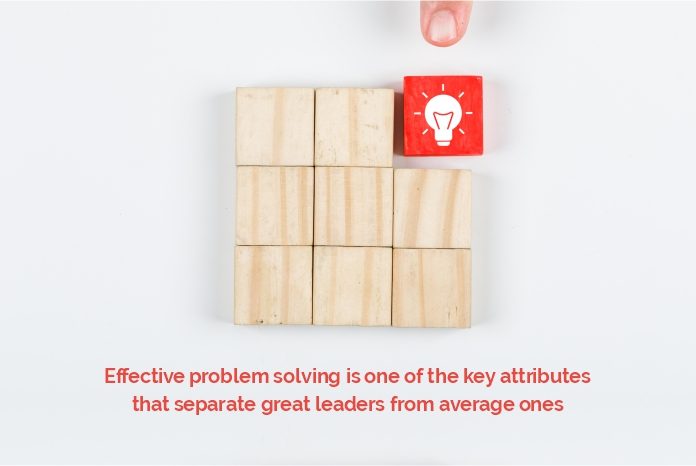Leadership consulting makes use of several strategies to accomplish the desired goal. A mentoring program may be implemented to allow department heads and supervisors to learn more about the management techniques used by upper-level managers. Today’s leadership responsibilities and roles aren’t limited to delegating and management. Instead, when it comes to effective leadership, problem-solving is not only an important skill but a crucial role for leaders to take on.
Problems are inevitable in the workplace, so developing problem-solving skills is helpful for management to learn how to identify problems as they arise and determine effective solutions. Studying different methods for problem-solving can help leaders prevent and approach difficult situations in a positive, relevant, and successful manner.
Understanding Problem-Solving: A problem well stated is a problem half solved
As a leader, you need to approach problem-solving as an opportunity, with a broad perspective and a calm demeanor. And, you’ll want to arm yourself with a few critical approaches to hone your problem-solving skills. Understanding your problem is half the solution.
Learning how to break down and solve complex problems is a core skill you need in today’s business world. A leader must never view a problem as a distraction, but rather as a strategic enabler for continuous improvement and opportunities previously unseen. Management demands action, not talk and collaborative analysis. Especially the kind of meetings that involves debate and discussion are seen as “just talk”. This is understandable considering the number of meaningless meetings most people experience, but debates and discussions are necessary to create a shared understanding of a problem.
Basic steps in problem-solving
- Build trust with your team so they feel comfortable talking to you if they’re struggling with a problem. If they’re concerned about repercussions from you, they may avoid sharing it with you.
- Because you’re already good at solving problems, you also may be tempted to solve them for your team. Instead, avoid the impulse to do it for them and work with them to address problems, along the way building their capability to do it themselves. Problems get solved better and faster at the lowest level possible, so work with people to develop problem-solving skills.
- As you grow as a leader, the size of your problems will grow too. It’s critical to continue to develop your process, ask the right questions, and get all the facts to find the best solutions.
Tips for Effective Problem-Solving
You’ll be able to solve problems in your role better as you grow in your industry-specific knowledge. Whether you are a leader for a large corporation or a small business owner, here are some effective ways to solve problems.
- Transparent Communication
- Be Open-minded To People
- Build A Solid Foundational Strategy
- Defining the Problem: In almost every problem-solving methodology the first step is defining or identifying the problem. It is the most difficult and the most important of all the steps. It involves diagnosing the situation so that the focus is on the real problem and not on its symptoms. Deeply understanding a problem through research, leads to better solutions. Research can include interviewing, reading books and emails, analyzing financial data, searching your organization’s intranet, and organizing your findings.
- Brainstorming: Creating a myriad of new solutions quickly. In group brainstorms, allow everyone to state ideas. Brainstorming combines a relaxed, informal approach to problem-solving with lateral thinking. It encourages people to come up with thoughts and ideas that can, at first, seem a bit crazy. Some of these ideas can be crafted into original, creative solutions to a problem, while others can spark even more ideas. Appreciate all input, and avoid criticism. Then, organize solutions into groups around common themes.
- Analyzing: Using disciplined thought processes to evaluate each possible solution. The ability to examine information or a situation in detail to identify key or important elements, their strengths, and weaknesses and use these to compile a persuasive argument, make recommendations or solve a problem.
- Managing Risk: Risk management in problem-solving is a critical skill required for construction and effective leadership at all levels. Anticipating and trying to avoid the downsides of key solutions. Your team can list potential risks, rate how likely each is, predict a date by which each might either happen or no longer be an issue, and think of ways to reduce those risks. Once risks have been identified, along with their likelihood and their impact on a situation or the organization, it must then be decided as to what the best way to manage each is.
- Deciding: Decision-making skills are important because they can help you to navigate a variety of situations that might come up at work. The ability to decide on a solution and move forward with it. After an appropriate amount of time, an analysis of possible solutions, and feedback from team members, a designated decider must choose and implement a solution.
- Managing Emotions: Emotional intelligence is all about how well you understand your own emotions and the emotions of others, and the ability to identify and manage them. Applying emotional intelligence to improve your and your team members’ ability to think clearly. This requires you to recognize emotions in yourself and others, manage feelings, and channel emotions into useful work.





